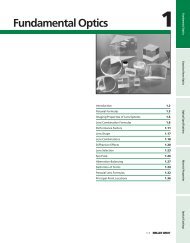Intel PXA250 and PXA210 Applications Processors
Intel PXA250 and PXA210 Applications Processors
Intel PXA250 and PXA210 Applications Processors
Create successful ePaper yourself
Turn your PDF publications into a flip-book with our unique Google optimized e-Paper software.
MultiMediaCard (MMC)<br />
5.1.2 How to Wire<br />
Notice in the example schematic (Figure 5-1, “<strong>Applications</strong> Processor MMC <strong>and</strong> SDCard Signal<br />
Connections” on page 5-3) an SDCard socket is used. The signals on the socket are defined in<br />
Table 5-2.<br />
Table 5-2. SDCard Socket Signals<br />
Signal Name Pin #<br />
DAT3 1<br />
CMD 2<br />
VSS1 3<br />
VDD 4<br />
CLK 5<br />
VSS2 6<br />
DAT0 7<br />
DAT1 8<br />
DAT2 9<br />
As stated previously, the <strong>PXA250</strong> MMC controller can be connected to either an MMC device or<br />
an SDCard device, but you are limited to which device installs in which socket. Refer to Table 5-3<br />
for information on sockets <strong>and</strong> device supported by the MMC controller.<br />
Table 5-3. MMC Controller Supported Sockets <strong>and</strong> Devices<br />
Sockets<br />
Devices Supported<br />
SDCard socket<br />
MMC socket<br />
SDCard device<br />
MMC device<br />
MMC device<br />
Figure 5-1 is a schematic that supports both MMC <strong>and</strong> SDCard devices. In the schematic, the<br />
signals SA_MMCLK, SA_MMCMD, <strong>and</strong> SA_DAT correspond to the applications processor<br />
signals MMCLK, MMCMD, <strong>and</strong> MMDAT, respectively. These three signals are also directly<br />
connected to the socket.<br />
5-2 <strong>PXA250</strong> <strong>and</strong> <strong>PXA210</strong> <strong>Applications</strong> <strong>Processors</strong> Design Guide
















